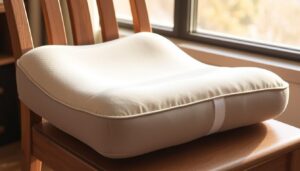New moms often get wrist strain from lifting and caring for their babies. This can cause pain and make simple tasks hard.
Wrist braces can help ease this pain. They offer support and stability. This lets new moms do daily tasks without trouble.
Key Takeaways
- New moms are prone to wrist strain due to repetitive baby care activities.
- Wrist braces can help alleviate discomfort and support recovery.
- Choosing the right wrist brace is crucial for effective support.
- Wrist braces provide necessary support and stability for daily tasks.
- Using a wrist brace can improve overall comfort and reduce pain.
Understanding Wrist Pain in New Mothers
Wrist pain is common in new moms. It comes from caring for a baby. This can strain and hurt the wrist.
Common Causes of Postpartum Wrist Pain
New moms often hurt their wrists. This is from lifting, holding, and feeding babies. De Quervain’s tenosynovitis and carpal tunnel syndrome are big reasons for this pain.
De Quervain’s Tenosynovitis: The “Mommy Thumb”
De Quervain’s tenosynovitis affects the tendons on the thumb side of the wrist. It’s called “Mommy Thumb” because it’s common in new moms. It hurts when you make a fist, grasp, or turn your wrist.
Carpal Tunnel Syndrome in New Mothers
Carpal tunnel syndrome happens when the median nerve gets squeezed at the wrist. It causes numbness, tingling, and weakness in the hand. New moms are at risk because of the baby care motions.
| Condition | Symptoms | Causes |
|---|---|---|
| De Quervain’s Tenosynovitis | Pain, tenderness, swelling | Repetitive thumb motion |
| Carpal Tunnel Syndrome | Numbness, tingling, weakness | Median nerve compression |
Why Wrist Braces Are Essential for Postpartum Recovery
Wrist braces are key for new moms to feel better and heal. They help with the pain from caring for babies. This includes lifting, feeding, and changing diapers.
The Biomechanics of Infant Care and Wrist Strain
Activities like lifting and feeding babies put stress on the wrist. This can make carpal tunnel syndrome worse. An ergonomic brace helps by supporting the wrist.
How Braces Provide Support During Healing
Wrist braces help with carpal tunnel support. They keep the wrist still, helping it heal. This is very important for new moms.
Using a wrist brace can prevent more injuries. It helps new moms recover faster. Knowing about wrist braces helps new moms take care of their wrists.
Types of Wrist Braces for Moms
Wrist pain is common in new moms. The right wrist brace can help a lot. There are many types of wrist braces, each for different needs.
Splint-Style Braces
Splint-style braces are stiff or semi-stiff. They keep the wrist still. They’re great for serious wrist injuries or Carpal Tunnel Syndrome.
An ergonomic brace like this is good for new moms. It helps keep the wrist stable while doing daily tasks.
Compression Sleeves
Compression sleeves are flexible. They support the wrist but let it move. They’re good for mild to moderate wrist strain.

Thumb Spica Braces
Thumb spica braces support the wrist and thumb. They’re perfect for De Quervain’s Tenosynovitis, or “Mommy Thumb.”
Day vs. Night Braces
Some braces are for daytime, others for nighttime. Day braces are flexible for more movement. Night braces are stiffer for better support while sleeping.
Key Features to Look for in Wrist Braces for Moms
For new moms, finding a wrist brace that meets their specific needs is crucial for comfort and recovery. When selecting a wrist brace, several key features should be considered to ensure effectiveness and comfort.
Material Considerations
The material of the wrist brace is vital for both comfort and durability. Breathable materials such as neoprene or mesh are recommended. They help prevent irritation and allow for airflow, keeping the skin dry. An ergonomic brace designed with the right materials will provide the necessary support without causing additional discomfort.
Adjustability and Fit
An adjustable wrist brace is essential for achieving a proper fit. Velcro straps or elastic closures allow for customization. This ensures the brace stays in place without being too tight. A well-fitting brace is crucial for providing the right amount of support and for effective pain management.
Breathability and Comfort
Breathability directly impacts comfort, especially during extended wear. Look for wrist braces with moisture-wicking properties to keep the skin dry and cool. This feature is particularly important for new moms who may wear the brace for long periods.
Washability and Maintenance
A washable wrist brace is a practical choice for new mothers, as it allows for easy cleaning and maintenance. Check if the product review recommends a brace that is machine washable or easy to hand wash. This ensures hygiene and longevity.
In conclusion, when choosing a wrist brace, new moms should consider factors such as material, adjustability, breathability, and washability. By focusing on these key features, they can find an ergonomic brace that provides the necessary support and comfort during the postpartum recovery period.
How to Properly Measure for a Wrist Brace
Getting the right wrist brace size is important for comfort after having a baby. It’s all about the right fit for support and comfort.
Step1: Gather Measuring Tools
You’ll need a flexible measuring tape or a string and a ruler. A flexible measuring tape is best for wrapping around your wrist.
Step2: Find the Correct Measurement Points
Put the measuring tape around your wrist just below the crease. Make sure it’s not too tight or too loose. Remember the measurement in inches or centimeters.
Step3: Record and Compare to Size Charts
After getting your measurement, check it against the size chart. Brands can size differently, so always check.
| Wrist Circumference | Brace Size |
|---|---|
| 6-7 inches | Small |
| 7-8 inches | Medium |
| 8-9 inches | Large |
Common Sizing Mistakes to Avoid
Don’t measure at the wrong spot on your wrist. Measure at the widest part for the best fit. Also, remember that some braces can adjust.
Top Recommended Wrist Braces for Moms
For new moms, wrist pain is a big deal. The right wrist brace can help a lot. There are many wrist braces out there. We’ll look at two top picks that are great for moms.
Mueller Fitted Wrist Brace

The Mueller Fitted Wrist Brace gives your wrist lots of support. It’s made of a soft, breathable material. This makes it comfy to wear all day.
Pros
- Excellent Support: This brace keeps your wrist still, helping it heal.
- Adjustable: You can adjust the straps to fit your wrist just right.
- Comfortable: It’s soft and lets air through, so it’s comfy to wear.
Cons
- Sizing: Make sure to measure right, as some find it too small or too big.
- Bulkiness: It’s a bit thick, which might not be good for some activities.
Futuro Deluxe Wrist Stabilizer
Overview
The Futuro Deluxe Wrist Stabilizer is a good mix of support and flexibility. It helps with pain but still lets your wrist move a bit.
Pros
- Versatile: You can wear it during the day or at night, and it’s flexible.
- Easy to Use: It’s simple to put on and take off.
- Effective Pain Relief: Many people say it really helps with pain.
Cons
- Fit: Some say it doesn’t fit as tightly as they’d like.
- Durability: Some have noticed it doesn’t last as long as they hoped.
Both the Mueller Fitted Wrist Brace and the Futuro Deluxe Wrist Stabilizer are good choices for moms with wrist pain. Think about how much support you need, how comfy it is, and if you can adjust it. This will help you pick the best one for you.
Best Compression Sleeve Options for Mild Wrist Strain
New moms with mild wrist strain find relief in compression sleeves. These sleeves support and compress to ease pain and aid healing. We’ll look at Copper Compression Wrist Sleeve and CompressionZ Wrist Support.
Copper Compression Wrist Sleeve
Overview
The Copper Compression Wrist Sleeve gives focused support and compression. It has copper-infused fabric. This fabric is thought to help recovery by boosting blood flow and cutting down on swelling.
Pros
- Effective Compression: It gives the right compression for wrist strain relief.
- Copper-Infused Fabric: It helps in healing and lowers swelling.
- Moisture-Wicking: It keeps your skin dry and comfy.
Cons
- Sizing Issues: Some find sizing not always right.
- Initial Odor: The copper can smell a bit when new.
CompressionZ Wrist Support
Overview
CompressionZ Wrist Support is also great for mild wrist strain. It has graduated compression to lessen swelling and help healing.
- Graduated Compression: It cuts down swelling and aids in healing.
- Comfortable Fit: It’s made for long wear without discomfort.
- Versatile: Good for sports and daily use.
Cons
- Limited Size Options: May not fit all wrists well.
- Material: Some say it’s not as breathable as others.
Both Copper Compression Wrist Sleeve and CompressionZ Wrist Support help new moms with mild wrist strain. Knowing the good and bad of each helps choose the best for your needs.
Premium Thumb Spica Braces for De Quervain’s Relief
Premium thumb spica braces are great for new moms with De Quervain’s tenosynovitis. They support the thumb and wrist well. These areas are often hurt by this condition.
Vive Thumb Spica Splint
Overview
The Vive Thumb Spica Splint is a top pick for De Quervain’s relief. It keeps the thumb still, helping the tendons heal.
Pros
- Effective Immobilization: The splint keeps the thumb still, helping it heal.
- Comfortable Design: People like how comfy it is, making it easy to wear all day.
- Adjustable: It fits different thumb sizes well, thanks to its adjustable design.
Cons
- Limited Breathability: Some say it could breathe better.
- Sizing Issues: A few had trouble finding the right size, so measuring is key.
Mueller Thumb Stabilizer
Overview
The Mueller Thumb Stabilizer is also good for De Quervain’s tenosynovitis. It balances support and flexibility well.
Pros
- Versatile: It works for De Quervain’s and general thumb support.
- Breathable Material: It’s made to be comfy and breathable.
- Easy to Use: Putting it on and adjusting is simple.
Cons
- May Not Provide Maximum Immobilization: Some think it doesn’t hold the thumb as still as others.
- Durability Concerns: A few worry it might not last long.
| Product | Immobilization | Comfort | Breathability |
|---|---|---|---|
| Vive Thumb Spica Splint | High | High | Moderate |
| Mueller Thumb Stabilizer | Moderate | High | High |
Budget-Friendly Wrist Braces for Moms
Wrist pain is common for new moms. But, there are affordable wrist braces that help. These are great for moms who need help without spending a lot.
ACE Brand Wrist Support
Overview
The ACE Brand Wrist Support is loved by new moms. It’s cheap and works well. It helps with wrist pain.
Pros
- Affordable: It’s cheaper than many other braces.
- Adjustable: Fits different wrist sizes.
- Comfortable: It’s made to be comfy to wear.
Cons
- Limited Support: It might not help with very bad wrist injuries.
- Durability: Some say it’s not as long-lasting as pricier options.
OTC Wrist Splint
Overview
The OTC Wrist Splint is another cheap option. It helps with wrist strain or injury.
Pros
- Easy to Use: It’s simple to put on and take off.
- Versatile: Good for day and night use.
- Cost-Effective: It’s a cheap way to handle wrist pain.
Cons
- Fit Issues: Some find it too big or too small.
- Material: The material might not be comfy for long wear.
| Wrist Brace | Price Range | Adjustability | Comfort Level |
|---|---|---|---|
| ACE Brand Wrist Support | $15-$25 | Yes | High |
| OTC Wrist Splint | $10-$20 | Yes | Medium |
How to Properly Apply and Wear Wrist Braces for Moms
Using wrist braces right can make new moms feel better. They help with wrist pain after having a baby. But, they only work well if used correctly.
Step1: Prepare Your Wrist and Brace
Make sure your wrist is clean and dry before putting on the brace. Take off any lotions or creams. Always follow the instructions from the maker.
Step2: Position the Brace Correctly
Put the brace on your wrist, making sure it’s in the middle and feels good. It should support your wrist but let you move a bit. Adjust it so it fits just right.
Step3: Secure Fasteners for Optimal Support
Follow the maker’s directions to tighten the fasteners. The brace should be snug but not too tight. This can hurt or cut off blood flow. Make sure it doesn’t make your wrist numb or tingle.
Daytime vs. Nighttime Wearing Guidelines
How long to wear the brace depends on the type and how much pain you have. Usually, wear it when you’re doing things that hurt your wrist. You might also wear it at night to avoid pain while sleeping. But, always listen to what your doctor says.
By following these steps and tips, new moms can use wrist braces to ease wrist pain. This makes them more comfortable and able to take care of their babies better.
Caring for Your Baby While Wearing Wrist Braces
Mothers with wrist pain can still take care of their babies. Wearing wrist braces helps with daily tasks. It also keeps the injury from getting worse.
Breastfeeding Adaptations
Breastfeeding is special, and wrist braces don’t get in the way. A breastfeeding pillow can help your wrists. Also, sitting up straight and using pillows helps a lot.
Diaper Changing Techniques
Changing diapers should not hurt your wrists. Use a diaper changing pad at a good height. This makes bending less. Keep everything you need close to avoid moving your wrists too much.
Bathing and Dressing Your Baby
Bathing and dressing can be hard with wrist pain. Use a baby bathtub for easy bathing. It’s at a height that doesn’t hurt your wrists. Lay your baby flat for dressing. Use easy-to-use baby clothes to make it simpler.
Safe Baby Carrying Methods
Carrying your baby safely with wrist braces is possible. Use supportive baby carriers that spread out the baby’s weight. This eases the strain on your wrists. Try not to lift or bend too much.
With these tips, moms can keep caring for their babies even with wrist pain.
Complementary Treatments for Mom Wrist Pain
Caring for a newborn can hurt a new mom’s wrists. But, there are many ways to feel better. Using wrist braces is one way. There are also other therapies and changes that can help.
Gentle Stretching Exercises
Doing gentle stretches can make your wrists feel better. You can do simple moves like extending, flexing, and rotating your wrists. For example, hold your arm straight and move your wrist up and down.
Ice and Heat Therapy
Ice and heat can help with wrist pain. Ice reduces swelling, and heat relaxes muscles. Switching between ice and heat can really help.
Anti-Inflammatory Approaches
Changing what you eat and taking supplements can also help. Eating foods with omega-3s and antioxidants can fight inflammation. Turmeric and ginger are good for this too.
Ergonomic Adjustments for Baby Care
Changing how you do baby care can also help. Hold the baby close, use both hands when lifting, and make sure surfaces are at a good height.
| Treatment | Description | Benefits |
|---|---|---|
| Gentle Stretching | Regular wrist exercises | Improved flexibility, reduced strain |
| Ice and Heat Therapy | Alternating ice and heat application | Reduced inflammation, relaxed muscles |
| Anti-Inflammatory Approaches | Dietary changes and supplements | Reduced inflammation, overall health |
| Ergonomic Adjustments | Adjusting baby care activities | Reduced wrist strain, comfortable positions |

By adding these treatments to your daily life, new moms can feel a lot better. It makes being a mom easier and less painful for your wrists.
When to Wear and When to Rest: Creating a Wrist Care Schedule
Creating a wrist care schedule helps postpartum women a lot. It’s about knowing when to use wrist braces for moms and when to rest.
Step1: Identify High-Risk Activities
First, find out what activities hurt your wrists the most. This could be lifting your baby, breastfeeding, or typing. Knowing these activities helps you plan when to wear your brace.
Step2: Plan Brace Wearing Times
After finding out what activities strain your wrists, plan to wear your carpal tunnel support brace during those times. For example, wear it while breastfeeding or lifting your baby. It gives your wrists the support they need.
Step3: Schedule Rest and Rehabilitation Periods
It’s also key to schedule rest for your wrists. Take off your brace and stretch your wrists gently during these times. This balance is good for healing.
Gradually Reducing Dependence on Braces
As your wrist gets better, you can use your brace less. Start by taking it off for short times. Then, slowly increase how long you go without it as your wrist gets stronger.
Maintaining and Cleaning Your Wrist Braces
To get the most out of their wrist braces for moms, new mothers should follow a regular cleaning and maintenance routine. This not only ensures hygiene but also prolongs the lifespan of the brace.
Daily Quick Cleaning
After each use, gently wipe the wrist brace with a soft, dry cloth. This removes dirt or sweat. It helps prevent bacteria buildup and keeps the brace fresh.
Weekly Deep Cleaning
Once a week, wash the wrist brace with mild soap and lukewarm water. Use a soft-bristled brush to gently scrub away dirt. Rinse well and let it air dry.
Proper Drying and Storage
After cleaning, store the wrist brace in a well-ventilated area, away from direct sunlight. Avoid folding or creasing the brace, as this can cause damage.
When to Replace Your Wrist Brace
If you notice signs of wear and tear, such as fraying, loosening of the material, or a persistent odor, it may be time to replace your wrist brace. Regularly inspect your brace to ensure it remains effective.
When to Seek Medical Help for Wrist Pain
Wrist pain in new moms can be scary. It might mean you need to see a doctor. Wrist pain is common because of caring for a baby. But, some signs need a doctor’s check.
Warning Signs of Serious Conditions
Look out for these signs that mean you should see a doctor:
- Persistent pain that doesn’t get better with rest or simple treatments
- Severe pain that makes it hard to do daily things
- Numbness or tingling in your hand or fingers
- Weakness in your hand or wrist
- Visible deformity or swelling
If you notice any of these, get medical help. This is to check for serious issues like carpal tunnel syndrome or De Quervain’s tenosynovitis.
What to Expect at Your Doctor’s Appointment
At your doctor’s visit, they will check you thoroughly. They might:
| Examination Component | Description |
|---|---|
| Medical History | Look at your health and your wrist pain details |
| Physical Examination | Check your wrist for tenderness, swelling, and how it moves |
| Diagnostic Tests | Maybe do X-rays or nerve tests to find the cause |
Potential Medical Interventions
Treatment depends on what the doctor finds. It could be carpal tunnel support or physical therapy. Or, it might be injections or surgery if it’s bad.
Knowing when to see a doctor for wrist pain is key for new moms. It helps avoid lasting harm and helps you get better fast. If symptoms worry you, talk to your doctor right away.

Conclusion
Wrist pain is common for new moms. It comes from caring for their babies a lot. Wrist braces help a lot.
These braces support and stabilize the wrist. This makes it easier for moms to take care of their babies. It also helps prevent more pain.
Mom wrist pain can happen from many things. Like breastfeeding, changing diapers, and lifting the baby. The right wrist brace can really help with these tasks.
There are many types of wrist braces. You can pick the one that fits your needs best. This includes splint-style, compression sleeves, and thumb spica braces.
Using wrist braces with other treatments helps a lot. Gentle stretching, ice and heat, and ergonomic changes are good too. Always talk to a doctor if the pain doesn’t go away or gets worse.
FAQ
What is the best wrist brace for new moms experiencing wrist strain?
For new moms with wrist strain, the best brace depends on the issue. For carpal tunnel or De Quervain’s, try ergonomic or thumb spica braces. Mueller Fitted Wrist Brace and Vive Thumb Spica Splint are good choices.
How do I choose the right size wrist brace?
To pick the right size, wrap a flexible tape around your wrist. Then, check the size chart from the maker. This ensures a good fit.
Can I wear a wrist brace while breastfeeding or caring for my baby?
Yes, you can wear a wrist brace while doing these things. Choose one that’s comfy and lets you move. You might need to adjust it or pick a different one for different tasks.
How often should I clean my wrist brace?
Clean your wrist brace every day with a soft cloth and mild soap. For a deeper clean, wash it by hand weekly with mild detergent. Let it air dry.
Can wrist braces be worn during the day and at night?
Yes, you can wear wrist braces day and night, as advised by your doctor. Day ones are flexible, while night ones are stiffer for more support.
Are compression sleeves effective for mild wrist strain?
Yes, compression sleeves like Copper Compression Wrist Sleeve help with mild strain. They offer support and reduce swelling.
How long should I wear a wrist brace for postpartum wrist pain?
How long to wear a wrist brace for postpartum pain varies. It depends on how bad the pain is and how you’re healing. Always talk to a doctor for the best plan. POSTPARTUM DEPRESSION Definition & Meaning – Merriam-Webster
What are the warning signs that I should seek medical help for wrist pain?
If you have ongoing or severe pain, numbness, tingling, or weakness, see a doctor. These are signs you need help. A doctor can check and treat you right.
Related Posts
- The Ultimate Guide to Baby Care Ergonomics
- Postpartum Belly Wraps: Do They Really Work?
- Contact Ergomomics
- How to Prevent Neck and Shoulder Pain While Working From Home
- The Ultimate Guide to Pregnancy Ergonomics: How to Stay Comfortable and Supported
- Safe Lifting Techniques for Pregnant Moms
- Nursing Pillows That Protect Your Back
- Ergonomic Recliners for Pregnancy Support







